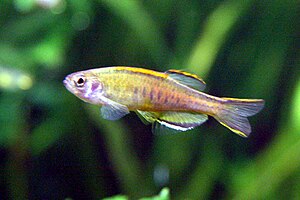Ruby harlequin
| Ruby harlequin | ||||||||||||
|---|---|---|---|---|---|---|---|---|---|---|---|---|

Glowlight danio ( Danio choprae ) |
||||||||||||
| Systematics | ||||||||||||
|
||||||||||||
| Scientific name | ||||||||||||
| Danio Choprae | ||||||||||||
| Hora , 1928 |
The ruby harlequin ( Danio choprae , syn .: Brachydanio choprai , Danio choprai ) or the glow-light harlequin , or snake-skin harlequin , belongs to the carp family (Cyprinidae), which is one of the most species-rich fish families with more than 1400 species. It inhabits the rivers in upper Myanmar , formerly Burma in Southeast Asia , Myitkyina district near Namma and Kamaing and in the Irawadi River.
features
Danio choprae , like all representatives of his closer and wider relatives, is not a schooling fish , in which individuals gathering together form a "higher organism". Bärblings live in close social groups and have a complex social structure which, in clear contrast to schooling fish like the herring, allows individual actions. The females are a bit fuller than the males. Because of its bright colors it is also commercially often than Glühlichtbärbling (Engl. "GlowLight Danio") offered. All too often, however, the ruby barb is easily confused with Devario maetangensis (Fang, 1997), which it looks like. A clear distinguishing feature , however, is the brighter color of Danio choprae , which is more brownish in D. maetangensis , and the much more pronounced horizontal stripes in D. maetangensis . In addition, the ruby barbel reaches a maximum size of around 3 cm in contrast to D. maetangensis with 5 cm. Danio choprae's body shape is stocky .
Care in the aquarium
The ruby barb is easy to keep and also to breed in soft, acidic to medium-hard, slightly alkaline water. Within a swarm, the dominant male is much more colorful than the other males. The male looks for the spawning site in delicate plants and tries to lure the female to the spawning site by showing the flanks. If the mating act is successful, the larvae hatch from the small clutch (around 50 eggs) after three days and swim free after another four days. From this point in time at the latest, the parent animals must be removed so that the offspring do not end up as live food. The preferred temperature is 22 to 24 ° C, but Danio choprae can also tolerate higher temperatures. Provided the animals are well fed, they spawn regularly every ten days.
swell
- Hans A. Baensch , Hans-Georg Evers : Aquariums Atlas. Volume 6, Mergus Verlag, Melle 2002, ISBN 3-88244-068-6 .
- Helmut Stallknecht : barbels and barbels. Tetra Verlag, Melle 1994, ISBN 3-89356-179-X .
- Christian-Peter Steinle: barbels and barbels. Ulmer Verlag, Stuttgart 1998, ISBN 3-8001-7433-2 .
Web links
- Ruby Barbel on Fishbase.org (English)
- Danio choprai inthe IUCN Red List of Threatened Species 2013.2. Posted by: Vishwanath, W., 2010. Retrieved December 17, 2013.